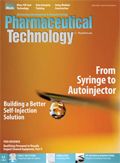News
Article
Pharmaceutical Technology
Examining Blow-Fill-Seal Technology for Aseptic Processes
Author(s):
Industry experts discuss common considerations and recent technological advancements in blow-fill-seal technology.
Blow-fill-seal (BFS) provides a sterile solution for aseptic technology by reducing human intervention in the fill/finish process. FDA’s guidance for the industry, Sterile Drug Products Produced by Aseptic Processing--Current Good Manufacturing Practice, defines BFS as “an automated process by which containers are formed, filled and sealed in a continuous operation” (1). BFS machinery must be designed to “prevent the potential for extraneous contamination,” FDA writes. Bill Hartzel, director, strategic execution, Catalent Pharma Solutions, says BFS can be used with a range of products, from simple solutions to complex biologics. Tim Kram, general manager, Rommelag USA, says, “BFS is best suited for single dose (unit-dose) aseptic and terminally sterilized drug products.” Some drug products suitable for BFS include respiratory, ophthalmic, oral, and injectable drugs.
BFS is internationally accepted as an advanced aseptic liquid processing technology, says Andy Goll, director of sales and marketing at Weiler Engineering. Goll attributes this recognition to the “inherent safety” in BFS processing of drug products, since there is very little, if any, human intervention during BFS processing. While BFS may reduce the likelihood of product contamination, there are several things to consider before selecting BFS technology. Products must be able to withstand momentarily high temperatures and long-term exposure to polymer (2). Factors such as wall thickness, material compatibility, sterility assurance, and product applications are just a few of the components impacting the success of BFS processes. Pharmaceutical Technology sat down with Hartzel, Kram, and Goll to discuss common considerations and technological advancements in BFS technology.
BFS and plasticsPharmTech: What types of plastic materials can be used with BFS?
Hartzel (Catalent): The primary materials used are medical grade polyolefins. For ophthalmic and respiratory products, where squeezability and flexibility are important for administration, low-density polyethylene (LDPE) predominates. For containers intended for storage, high-density polyethylene (HDPE) is more common, and polypropylene (PP) may be used if broader chemical resistance, enhanced barrier properties, or greater thermal stability are required.
Goll (Weiler): The main plastic materials used are LDPE, HDPE, and PP.
Kram (Rommelag): The most common are polyolefins: polyethylene (PE) and PP.
PharmTech: What are the considerations when choosing a type of plastic for an application?
Kram (Rommelag): The first check is to see if the product is directly compatible with the plastic resin. Rommelag has standard test kits with sterile 10-mL containers made from various plastics for this purpose. Extractable profiles for the plastics need to be examined for potential incompatibilities with the products. Accelerated and normal stability studies will be performed to find out what leachables are present and what the impacts are. This is the same process that would be performed on a glass vial and its rubber stopper.
The plastic needs to be able to provide the function the intended use requires. This may be a simple twist-off top or a more complicated feature. The plastic material will also be evaluated for water vapor permeability and gas permeability. Polyolefins have a good water vapor barrier but a gas barrier that is not sufficient for products that are highly sensitive to oxygen or other gases. Products that need additional barrier protection commonly use secondary foil overwraps.
BFS is an aseptic filling technology, but in the case of injectable products there is a regulatory requirement to perform an overkill terminal sterilization (if the product can withstand the procedure). The most common route for sterilization is steam autoclaving. The standard here is 121 °C. PP materials are the most suitable for this application. Injectable products have a regulatory requirement to be inspected for visible particulate. Other product types find it beneficial to have clearer containers. Resins with better clarity are typically preferred over others. Cost is a consideration when considering all the resin options available.
Goll (Weiler): The main considerations when choosing a plastic are the applications. When filling injectable products, for example, you will most likely need to terminally sterilize the products. If the product is not heat sensitive and can withstand a terminal sterilization cycle of 121 °C, then you would want to choose a PP that has the proper barrier characteristics to withstand the high temperature sterilization. The resin characteristics of PP are somewhat similar to that of glass. It is a much harder and more rigid material and often times can be a little more difficult to open depending on the application.
For most other applications where a high temperature terminal sterilization cycle is not required, LDPE would be the resin of choice. LDPE offers decent oxygen barrier characteristics and is quite successful in most extractable and leachable profiles depending on the product. There are many new LDPE resins which actually have characteristics that allow for a higher terminal sterilization temperature up to 115 °C. Most pharmaceutical blow molding grade LDPE resins offer very nice molding capabilities that allow for intricate detail for forming of the main body of the vial, and also opening features that may be more complicated when using PP or HDPE resins.
HDPE resins are more commonly used for large irrigation and eye-wash bottles where a preservative may be used in the formulation. HDPE has very good oxygen permeation/barrier characteristics to ensure a stable product with a slightly longer shelf life. In applications where a combination of the HDPE resin and a titanium dioxide mixture may be required, HDPE is quite frequently used due to the high extrusion temperatures and homogenous mixing characteristics of the two materials. HDPE is probably the least common resin chosen in most BFS applications.
Hartzel (Catalent): When choosing a plastic for a primary container closure; safety, efficacy of the product, and function of the container need to be considered. To check the compatibility, stability studies are required as well as the matching of the physical characteristics or function of the container to deliver the product. For example, if you have eye drops that are applied by squeezing the container to express a drop, you would choose LDPE. Alternatively, if you need to terminally sterilize the product with an autoclave you would choose the higher thermal stability of a PP container. Often, barrier properties are questioned because plastics are semipermeable. Even though there are different rates of permeation depending on plastics (e.g., PP has better barrier properties than LDPE), the use of a foil overwrap is a common practice to provide barrier properties that are similar to glass.
Temperature considerationsPharmTech: How long is the product/container at an elevated temperature and are there any concerns related to this?
Goll (Weiler): The BFS molds have chilled water running through the internal structure of the mold housings. As soon as the mold closes around the parison, the cooling process begins immediately. Additional cooling is applied simply due to the filling process of the liquid drug product. Most product formulations are chilled after batching, which adds an extra level of cooling to the internal surfaces of the vial or bottle. The temperature rise inside the vial is totally dependent on the process and application. Heat transfer studies have been conducted where the product inside the vial could see a temperature rise from 10 °C to 12 °C. This is dependent on the product temperature entering the vial, internal volume of the vial, and fill volumes inside the vial or bottle.
Hartzel (Catalent): This is one of the most frequently asked questions in BFS, especially as more thermally sensitive molecules (i.e., biologics), are evaluating the value of BFS. Catalent has been producing a thermally sensitive biologic using this technology. Additionally, the industry has done a significant amount of work to understand and optimize the control parameters to minimize the heat impact the BFS process can have on the product. This concern is derived from the fact the temperature of the molten plastic as it enters the mold is around 180 °C. However, from the data we have generated, the heat is dissipated extremely efficiently allowing the plastic material to cool rapidly in the mold. The main contributing variable is the container design itself, control of the container wall thickness, and fill volumes. Through the implementation of additional temperature controls on the formulation side of the BFS process, such as cooling the bulk solution and insulation, an average product temperature of approximately 23 °C can be maintained.
Kram (Rommelag): Methods are available to keep the heat impact upon the product minimal. Under normal situations, a product can either be filled under room temperature (20 °C) or be brought back to room temperature within a few minutes. Most products have heat sensitivity based on a temperature for a certain amount of time, or do not exceed a temperature. Typically, we are able to modify the BFS system to accommodate these product requirements. In the end, all products need to be tested with the BFS process. Not all products will be compatible.
Optimizing processesPharmTech: What should be considered when optimizing the processing conditions of the BFS equipment?
Kram (Rommelag): The most common considerations when optimizing BFS equipment processing conditions are container function and closure integrity. These two items are related. Wall thickness is a critical process condition for a twist-off top on a unit-dose drug container or a piercing point for a container feeding aseptic liquid to a device. [If the wall is too thick] the torque required to remove the twist-off, or energy to pierce the container, will be too high. [If the wall is too thin], the twist-off may be damaged during secondary packaging or transport and result in a leaking container. For container closure integrity, the most critical point is where the container is to be opened. At that point, the container has been purposely weakened so the closure functions properly. Optimization involves several mechanical systems found on the BFS equipment.
Hartzel (Catalent): Product quality and ensuring sterility are the most important considerations and this is always at the forefront of our process design. We need to understand the critical control parameters and ensure the sterile boundary is maintained and the process creates inert containers. As the next step, we evaluate the production efficiency, which is heavily influenced by the formulation, container design, and the packaging requirements of the product. Often times the industry focuses on just the BFS front but secondary packaging requirements are a significant contributor to the overall efficiency and many hidden costs.
Goll (Weiler): For the BFS process alone, special consideration should be given to process parameter development prior to the validation stage, in the form of an engineering study and proper execution of the process validation. Facility design, the utilization of proper utilities, training of operators, and understanding the BFS process will ensure success to anyone entering the field of BFS technology.
Technology advancementsPharmTech: How have recent technology improvements advanced BFS processing?
Goll (Weiler): As product applications become more accepted globally, markets requiring more stringent regulatory guidance are demanding process enhancements, which minimize risk for an added level of safety to the patient. The most recent advance for Weiler BFS technology is the introduction of NO2 gas sterilization for the grade A filling zone. In collaboration with Noxilizer, this new technology offers a safe and effective means of a complete 10³ endotoxin reduction. Since the grade A filling zone is the critical filling zone, NO2 offers the assurance of a complete decontamination or depyrogenation (customer dependant) cycle prior to the start of a filling campaign.
Hartzel (Catalent): In recent years, there have been several innovations, for example the introduction of a filling technology that can reduce particulates, and enhanced temperature controls of the process formulation. But the true innovation has revolved around leveraging the BFS technology to create better primary packages that ultimately assist patients and caregivers. The market is gaining a better understanding of how and where BFS fits into primary packaging design and the processing of aseptic products. The major technology improvements lie in companies taking advantage of the true value of BFS as an advanced aseptic manufacturing process that automates the formation and filling of a primary container closure. The technology can then be leveraged for new markets, and change the way a product is delivered to the patient. It is evident in the creation of new container closures that meet specific patient needs, such as closures with multiple ports, or a flat design that fits within a more compact delivery device. Ultimately, the technology facilitates container designs that can deliver products more effectively.
Kram (Rommelag): Disposable fill systems have been developed that work with BFS technology. This will allow higher-value products to be filled with lower losses than the traditional time-pressure-dosing systems, and reduce the time necessary to set up a machine compared to the standard clean in place/sterilize in place process. Rommelag has also developed a single mold variation for their closed parison rotary technology. This new system adds flexibility while keeping the high aseptic assurance levels offered by the closed parison technology. Other additions include automated vial inspection systems that perform IPC tests that are commonly done by hand, adding repeatability and the ability to give direct feedback to the BFS system. Automated particle inspection for injectable products has also been introduced.
References
1. FDA, Guidance for Industry, Sterile Drug Products Produced by Aseptic Processing--Current Good Manufacturing Practice (Rockville, MD, September 2004).
2. R. Hernandez, BioPharm International, 28 (7) 2015.
Article DetailsPharmaceutical Technology
Vol. 40, No. 6
Pages: 49â51
Citation
When referring to this article, please cite it as C. Hroncich, "Examining Blow-Fill-Seal Technology for Aseptic Processes," Pharmaceutical Technology 40 (6) 2016.
Newsletter
Get the essential updates shaping the future of pharma manufacturing and compliance—subscribe today to Pharmaceutical Technology and never miss a breakthrough.






